#Dyestuff
Explore tagged Tumblr posts
Text
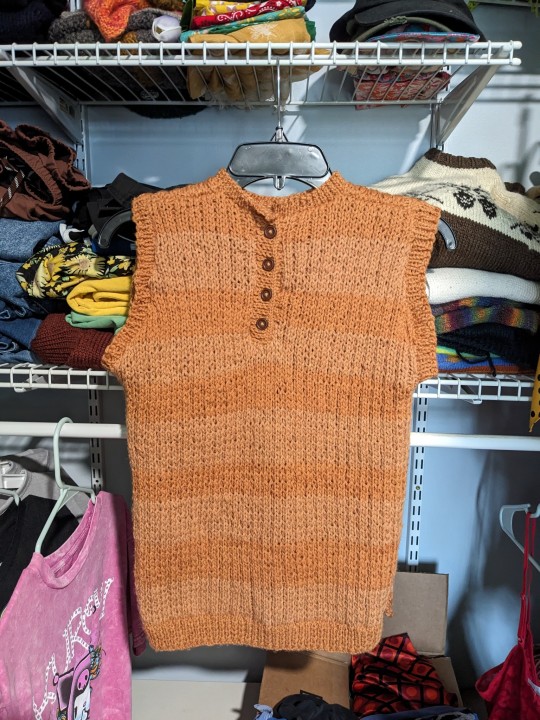
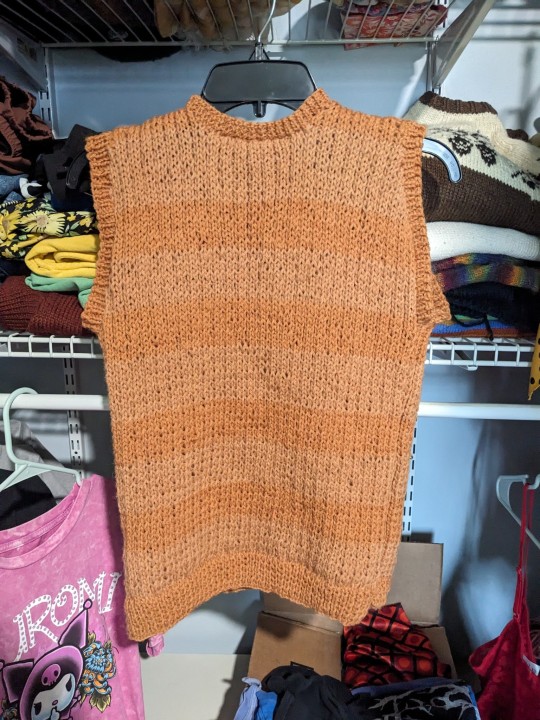

My onion skin dyed vest is done! 🧅 🧶 This is my first natural dyeing project & I had so much fun! I'm looking forward to learning more with the future projects I've planned
#natural dyeing#natural dye#onion skin dye#knitblr#knitters of tumblr#my knitting#dyestuff#dial p for post#it's been tough to get accurate colors but these ones are pretty spot on!
27 notes
·
View notes
Text
Leading Dyestuff , Dyesintermediates manufacturer| Hindprakash Chemicals
About Hindprakash Chemicals
Established in 1942, Hindprakash Chemicals Pvt. Ltd. has evolved into a prominent name in the manufacturing, import, and export of dyestuffs and dye intermediates in India. Over the decades, the company has diversified its product range to include textile auxiliaries, specialty chemicals, and other related products, catering to various industries such as textiles, paint, pharmaceuticals, and more
Our Product Range
At Hindprakash Chemicals, we offer a comprehensive array of products designed to meet the diverse needs of our clients:
Dyestuffs: Including acid dyes, cationic basic dyes, direct dyes, disperse dyes, and reactive dyes.
Dye Intermediates: We specialize in both the import and export of high-quality dye intermediates.
Chemicals & Solvents: Supplying basic chemicals and solvents essential for various industrial applications.
Chemicals & Auxiliaries: Offering pretreatment chemicals, dyeing auxiliaries, green acid, printing auxiliaries, finishing auxiliaries, and washing agents .
Pigments: Providing a range of pigments suitable for textiles and other applications.
Resins & Adhesives: Manufacturing resins and adhesives for diverse industrial uses.
Other Products: Including food colors and other specialty products.
Research & Development
Our in-house R&D facility enables the development of new products, improvement of existing processes, and enhancement of product quality. This commitment to innovation leads to cost reduction, better quality for customers, and a reduced environmental footprint. We also offer customized product development under secrecy agreements to meet specific client requirements .
Global Presence
With over 75 years in the industry, Hindprakash Chemicals has expanded its reach globally. We have established subsidiaries and partnerships in various countries, including Vietnam, China, and the UAE, to support our international business and cater to a diverse clientele .
Commitment to Quality
Quality is at the core of our operations. We have dedicated quality control laboratories equipped with modern testing instruments such as spectrophotometers, HPLC, dyeing and printing equipment, and fastness test equipment. These facilities ensure that all our products meet international standards and customer expectations .
Sustainability and Social Responsibility
Hindprakash Chemicals is committed to sustainable practices and social responsibility. We actively engage in activities that promote environmental sustainability and contribute positively to the communities we operate in.
Hindprakash Chemicals, established in 1942, is a leading manufacturer of dyestuffs, dye intermediates & specialty chemicals, committed to quality & innovation

0 notes
Text
So it seemed, given the material benefits – electric lights, trolleys, and machinery; phonographs, cinema, and radio; dyestuffs, fertilizers, and gasoline; anesthesia, medicines, and diagnostic X rays – that science had conferred upon the Anglo-American world since the late nineteenth century.
"In the Name of Eugenics: Genetics and the Uses of Human Heredity" - Daniel J. Kevles
#book quote#in the name of eugenics#daniel j kevles#nonfiction#material benefits#electric light#trolley#tram#machinery#phonograph#cinema#radio#dyestuff#fertilizer#gasoline#anesthesia#anaesthesia#medicine#x rays#science#anglo american#19th century
0 notes
Text
auhiufhdf i was just picking buckthorn berries, and i didnt realize until i was up close to the trees for a while but so many bugs live in them ! there was a particular little guy sitting on a ripe buckthorn berry waving its antennae at me. very good experience, highly recommend

#most of the berries are on the higher foliage that i cant really reach so i only got a handful from the two trees#but thats fine. a lot of them seem to fall on the ground too so i might pick some up later (not all--theres tons)#but given how many different dyestuffs im currently collecting i dont think i need large amounts of anything lmao#buckthorn
23 notes
·
View notes
Text
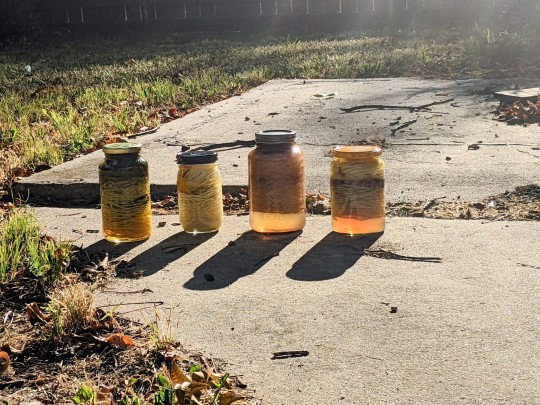
I decided to take advantage of the hot weather (100+ F for at least the next two weeks) and dedicated some time to Athena experimenting with solar dyeing. They've gotta sit for a week before I can rinse them & see the results. If they turn out well I'm going to use them to either knit or weave her a shrine cloth.
I'm using the process from Rosemary & Pines Fiber Arts. The jars are, from left to right: dried spearmint; onion skin and tea bags; all tea bags; and lemon peel, dried rose, and dried eucalyptus.
#i've been thinking about this for at least a couple weeks so it was nice to finally do it#this is the first time ive experimented with this since. like. spring 2022? i think?#and im already liking this process better than the one i found last time#though i am deeply missing having access to madder root#adding the mordant AND yarn AND dyestuffs all at the same time??? revolutionary#AND im not killing my lungs trying to mordant the yarn on the stove like last time#hopefully this will give me time to figure out what supplies my loom needs so i can get to work as soon as the skeins are finished#coriander says#helpol#hellenic pagan#hellenic polytheism#athena#hellenic gods#hellenic community#paganism#pagans of tumblr#natural dye#natural dyeing#solar dyeing#image id in alt text
2 notes
·
View notes
Text

At Rathi Dye Chem, we are proud to offer premium colour solutions that cater to a wide range of industries. Our dyes are carefully crafted to deliver lasting vibrancy, exceptional quality and consistency in every application.
We believe in the power of colour to transform products, enhancing both aesthetics and durability. Rathi Dye Chem innovative dyes bring your creations to life with unmatched brilliance.
Join us in revolutionizing your industry with the finest colour solutions. Together, we can create products that stand the test of time.
Discover more: https://rathicolours.com/
#RathiDyeChem #Sustainability #Dye #Colours #Sustainability #Innovation #Environment #Quality #RDC #Chemicals #Industries #Textile #Candles #Ink #Granite #Leather
#dye#colour solutions#solvent dyes#dye manufacturer#Dyes#Dyes and Pigment#Dyes Company#Dyestuff manufacturer#plastic dyes#Dye Manufacturer in India#Sustainable Dyes#Ecofriendly dyes#Dyes for wool#Disperse Dyes#Acid Dyes#Polymer Dyes#Speciality Dyes#Solvent Dyes Manufacturer#Pigment Dyes
0 notes
Text
RFK Jr. Rattles Food Companies With Vow to Rid Food of Artificial Dyes
In his first meeting with top executives from PepsiCo, W.K. Kellogg, General Mills and other large companies, Robert F. Kennedy Jr., the health secretary, bluntly told them that a top priority would be eliminating artificial dyes from the nation’s food supply. At the Monday meeting, Mr. Kennedy emphasized that it was a “strong desire and urgent priority” of the new Trump administration to rid the…
#Consumer Brands Assn#Dyes and Dyestuffs#Food#Food and Drug Administration#General Mills Inc#Health and Human Services Department#PepsiCo Inc.#Regulation and Deregulation of Industry#United States Politics and Government
0 notes
Text
Meghmani Global stands as a top choice among chemical and dyestuff manufacturers & suppliers in India. Learn more about our premium products and services that cater to diverse industries globally.
0 notes
Text
i loosely followed thedimelions’s tutorial for naturally dyeing a pride flag, with a lot of added research about natural dyes, stains, mordants, sewing, etc, and i wanted to share my results!!

process, notes, and more pics under the read more🌱
starting off i soaked my fabric (100% cotton acquired from joann's during their closing sale, rip joann's ;-;) in a 1:5 mixture of soy milk and water for 12 hours, then let dry on a clothesline in the sun, then dipped and dried two more times (the proteins in the soy milk help the natural dyes adhere to the fabric, creating darker colors and better colorfastness)

while that was happening i started making my dyes, which involved simmering my chosen dyestuffs in some water for 30-60 minutes. i didnt time it, just went until the color developed to a point i was happy with


as far as ratios i didn’t measure, but the more dyestuff = stronger color so err on the side of more
red: turmeric + baking soda, paprika, and yellow onion skin dye as the liquid base
orange: yellow onion skins
yellow: turmeric
green: red cabbage + baking powder (LOTS), turmeric
blue: red cabbage + baking powder
purple: red cabbage
for the red cabbage dyes, i added the baking powders and soda after simmering and just kept adding and stirring till i got the color i wanted. ((BIG NOTE red cabbage, and debatably most of the others that I used, are fugitive dyes, meaning its not a true dye and more of a stain that will fade with time and wash out more easily, especially without mordanting on additives like iron. keep this in mind if you end up doing this project or transfering these methods to cloth you will be using for clothes, ie washing and wearing more frequently))
i also tried to make a pink with avocado skins and pits, which did come out a lovely rosy color, but i didn’t end up using in the final flag, which i might use beet or red cabbage + lemon juice or another acidified for next time to get a more bright pink

now with my dyes ready and my cloth dried out from its previous soy milk dip i cut it into strips and stuck it in the jars, which were placed in the sun for the day (alternatively, you could simmer the cloth in the pot) and then left to sit overnight
the next day i squeezed out the excess dye and gave the ones with turmeric a light rinse to get the grit out, then hung them to dry
((small note i reused the dyes baths to see what would happen since they still looked just as pigmented, but the colors are much much much more faded on the second go around. all in all its doable, but I wouldn't recommend it.))
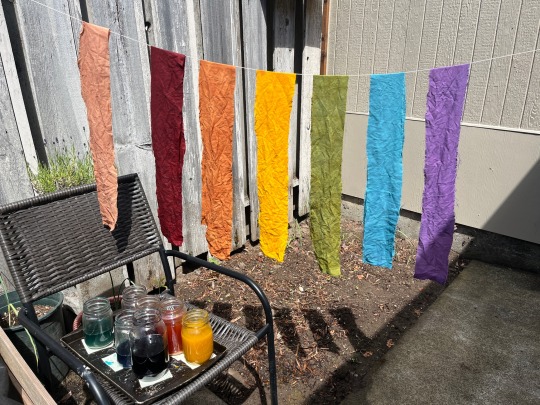

now time to sew! i procured a second hand sewing machine specifically for this project and had never sewed before, but thankfully this required the easiest stitch in the game (a straight stitch in a straight line). i looked up how to sew a flag specifically to get those clean lines rather than just overlapping, and this video was great (shoutout Suffolk Public Library)


as you can see my flag ended up quite long cause I left a lot of wiggle room, so I just look up flag ratios, trimmed it up (and used the extra strip of rainbow as decoration) then added a white strip folded over to make a way for me to hang it on a stick if I ever so desire.
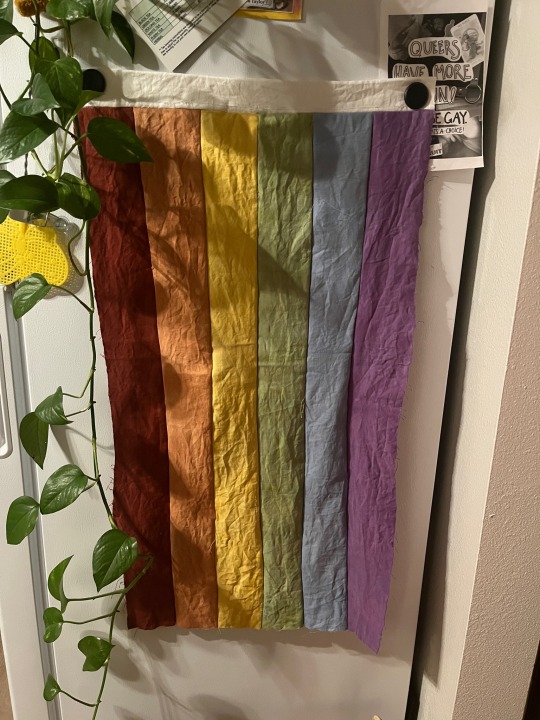
and ta daaa! i would still like to clean it up a bit, and do a zig zag stitch around the outside to stop the cloth from fraying further, but im happy with the unpolished look of it. once i figure out how to get a pink I like, and how to get browns and blacks, i want to make a progress flag and trans flag. also just started growing some indigo, so excited to see if I can get some blue dyes out of that.
2K notes
·
View notes
Text
Dyestuff for Cotton Market: Technological Advancements and Future Trends

The dyestuff for cotton market is a vital component of the textile industry, as cotton remains one of the most widely used fibers for textile production globally. The demand for vibrant and long-lasting colors in textiles has led to the growth of the dyestuff industry, particularly in the context of cotton. This article provides an overview of the dyestuff for cotton market, highlighting key trends and dynamics that influence its growth and development.
Market Size and Growth
The dyestuff for cotton market has experienced significant growth over the years, driven by various factors, including population growth, rising disposable incomes, and evolving fashion trends. Cotton is a preferred choice for clothing due to its natural and breathable properties, making it a staple in many wardrobes. This preference for cotton has stimulated the dyestuff market's expansion to meet the increasing demand for vibrant and diverse color options.
According to market research reports, the global dyestuff market for cotton was valued at approximately $4 billion in 2022 and is expected to grow at a CAGR of around 5% from 2023 to 2030. This growth can be attributed to the continual innovation in dyestuff technology, environmental regulations, and the quest for sustainable and eco-friendly options.
Trends in Dyestuff Technology
Advancements in dyestuff technology have been a key driver in the growth of the dyestuff for cotton market. Manufacturers are constantly working to develop more efficient and eco-friendly dyeing processes. Some notable trends in dyestuff technology include:
Eco-friendly dyes: With increasing concerns about environmental sustainability, there is a growing demand for eco-friendly dyes that reduce water consumption, energy use, and pollution. Eco-friendly dyeing processes, such as cold dyeing and digital printing, have gained popularity.
Nanotechnology: Nanotechnology has made its way into the dyestuff industry, enabling better dye penetration and adhesion to cotton fibers, resulting in enhanced color fastness and reduced dye consumption.
Digital printing: Digital printing technology has revolutionized the textile industry by offering precise and high-resolution color application, minimizing water wastage, and reducing the environmental impact of traditional dyeing processes.
Bio-based dyes: The development of dyes derived from natural sources, such as plants and microorganisms, is gaining traction as a sustainable alternative to traditional chemical dyes.
Sustainability and Environmental Regulations
Sustainability is a driving force in the textile industry and, by extension, in the dyestuff for cotton market. As consumers become more conscious of the environmental impact of their choices, there is a growing demand for sustainable products. Environmental regulations have played a significant role in shaping the dyestuff market. Many countries have stringent regulations in place to control the use of hazardous chemicals in textile dyeing processes.
To comply with these regulations and meet consumer demand for sustainability, dyestuff manufacturers are investing in research and development to create low-impact and non-toxic dyeing solutions. Waterless dyeing techniques, recycling systems, and waste reduction initiatives are becoming essential for businesses in the dyestuff sector.
Market Challenges
While the dyestuff for cotton market offers substantial growth opportunities, it also faces several challenges:
Rising raw material costs: The prices of raw materials used in dye production, such as petrochemicals and intermediates, can be volatile, affecting the cost structure of dyestuff manufacturers.
Competition from synthetic fibers: The popularity of synthetic fibers like polyester and nylon is on the rise, posing competition to cotton and subsequently affecting the dyestuff market's growth.
Technological barriers: The adoption of new and sustainable dyeing technologies can be expensive and complex for manufacturers, hindering their transition to eco-friendly alternatives.
Geopolitical factors: Trade tensions, tariffs, and political instability in key cotton-producing regions can disrupt the cotton supply chain and influence the dyestuff market.
Opportunities for Growth
Despite these challenges, the dyestuff for cotton market growth offers several opportunities for growth and innovation:
Sustainable practices: Embracing sustainable practices not only meets consumer demand but also reduces production costs in the long run by optimizing resource utilization.
Collaboration with fashion brands: Partnering with fashion brands committed to sustainability can create a significant market niche for dyestuff manufacturers.
Customization and personalization: Offering customized dyeing solutions to meet the diverse and unique demands of customers can be a competitive advantage.
Expanding in emerging markets: Emerging markets in Asia, Africa, and Latin America present significant growth potential due to increasing disposable incomes and a rising middle-class population.
Conclusion
The dyestuff for cotton market plays a pivotal role in the textile industry, offering a wide range of colors and options to consumers. As the industry strives to become more sustainable and eco-friendly, dyestuff manufacturers are facing both challenges and opportunities. The growth of the market depends on their ability to adapt to changing consumer preferences, comply with stringent environmental regulations, and embrace innovative and sustainable technologies. The dyestuff for cotton market is poised for continued growth, driven by the ever-evolving world of fashion and the increasing emphasis on environmental responsibility.
#Dyestuff for Cotton Market Share#Dyestuff for Cotton Market Growth#Dyestuff for Cotton Market Demand#Dyestuff for Cotton Market Trend#Dyestuff for Cotton Market Analysis
0 notes
Text
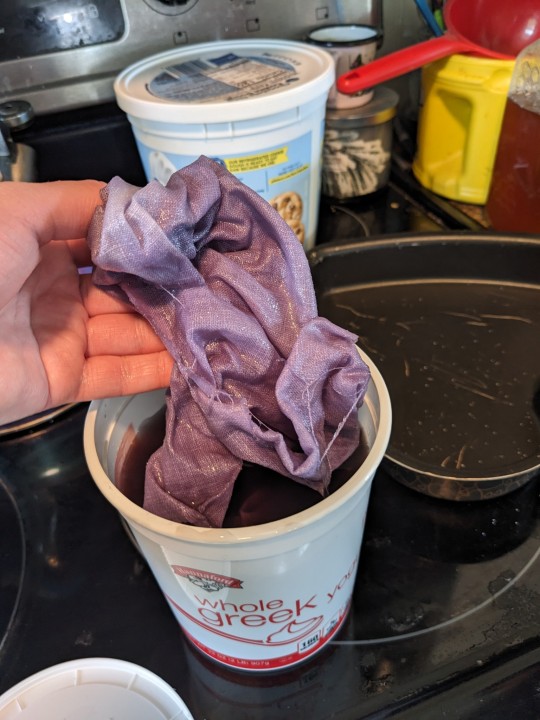

black bean dye + avocado pit dye. the yarn turned out how I wanted, so now I have a formula for a whole sweater! I'm really excited to see if the linen stays this pretty purple or if it'll turn blue once it's done.
#dyestuff#dial p for post#i am overdyeing the avocado linen bcuz since i have SO much more yarn to dye for that sweater i will have PLENTY more where that came from#in that case i'll overdye pieces multiple times to see if i can get a darker pink that stays#natural dyeing#black bean dye#avocado dye
12 notes
·
View notes
Text
Dyestuff Manufacturers in India Hindprakash Chemicals
HindPrakash is a leading dyestuff manufacturer, offering premium quality dyes for various industries. Discover vibrant, durable color solutions for your needs We are Since 1942 Century Dyestuff , Dyesintermediates manufacturer founded on 10 core values.
0 notes
Note
Oh hey! I think @panickingstudent2 may be referencing one of my videos, which if true that's a very weird feeling, because that video has I think around two hundred views. Anyway, the I think the asker possibly was referencing is my video about the portrait of Feyntje von Steenkiste, the wife of a wealthy Mennonite merchant, painted in the early 1600s, in which I talked about how her very severe presentation was a bit of conspicuous consumption, and included in this I talked about her black dress.
So what I talked about in that video is the fact that at the time a black dress would have been dyed with the new hot dye from the New World, logwood dye, which if properly treated created a fairly stable black dye, something that had not been avaible in Europe before. I talked about how this dye would have been expensive but I also talked about how this dye would have been acquired from the Portuguese possessions in South America, and that this would have had religious implications for a staunch Protestant at the time.
But I want to talk a little bit about why black dyed clothing was a sign of conspicuous consumption in the late middle ages, before the availibility of logwood dye, because black was really, really fashionable in the Iberian Peninsula, and Spanish influenced courts like Burgundy, before there was a colorfast black dye availible. Before logwood, black was derived mostly through overdying, which is to say dying a fabric repeatedly with multiple dyes in multiple baths. It is possible to get a colorfast color this way today, depending on the dyes, mortants, and process, but unfortunately they did not have the means of creating a colorfast black dye at the time. So before logwood, having black clothing was conspicuous consumption because the clothing had to be to an extent disposable. The black was not going to last, and the dye was not going to fade evenly. You could probably reuse the garment, by re-dying it, But any decoration on it would be ruined, so would have to be taken out and redone. This could be a very expensive process. It wasn't that black clothes themselves were individually more expensive in the late middle ages than any other color, but because the garment would not last as long, you are making a statement about your ability to afford to regularly discard and replace clothes. Which given how expensive high quality textiles were, was a real statement.
As a side note, given the Spanish associations with this particular late medieval trend for black, it might have been a way of dealing with the high quality dark brown merino wool. To be clear, I'm spitballing here, but hey, I wouldn't be surprised.
I would not be surprised if the asker is not referencing my video, because again, very few people actually saw it, it just felt so similar to what I had talked about.
So I've seen conflicting stories about the colour black in history.
Some say it's very expensive and hard to maintain, so that's why rich merchants wore black. Evidence in portraits.
Some say that for dyes it's on the cheaper side actually.
Some say the expensive black doesn't come from dye but rather the colour of the animal, so black fabric comes from black fibre which comes from black sheep. How exactly would black sheep be more expensive than regular white sheep?
Which one is right? I know this is probably influenced by which century it's set in, like maybe some eras have an easier time getting black dye
I found a well-sourced blog post about this, luckily, because I'm a 19th-century focused researcher and I've heard conflicting things about black in earlier periods. It seems to be that high-quality black-dyed fabric was difficult to obtain in the west from the Middle Ages potentially through the 18th century because it required massive amounts of dye to get the color very deep ("true black"). Lesser black shades were quite common, though, so black, period, doesn't seem to be more expensive than any other color. Possibly the intensively dyed, deep blacks might have been? But not black in general.
source
Rich merchants did wear black- but so did other people. They just usually didn't have portraits.
The black sheep thing I've never heard before. And anyway, that could only apply to wool- not cotton, linen, silk, leather, etc.
#a s fischer added#The only thing I could think the entire time. I was writing this was medieval fast fashion#I also talked in that video about how the rice starch commonly used at the time for stiff linen ruffs and also the logwood dye for the dres#were products produced by enslaved black and indigenous people#But anyway the reason why everybody lost their mind when logwood dye was introduced was because black was already very trendy#At least in certain parts of western europe#logwood made black clothing much more accessible and less expensive even if it was itself an expensive dyestuff
2K notes
·
View notes
Text
list of "beautiful" words found in a virtual space
I went through my following/followers lists and collected "beautiful" words and phrases from usernames and blog titles to try to include in your next poem/story
Amour Propre - self-esteem
Ephemeral - lasting a very short time
Espiègle - tending to or exhibiting reckless playfulness
Forgotten faith - faith that has ceased to be remembered
Jovial - characterized by good-humored cheerfulness and conviviality
Moonstruck sun - a sun affected by the moon
Poetic scars - scars that have qualities of poetry
Psychosomatic - of, relating to, concerned with, or involving both mind and body
Nyctophilia - the condition of being very happy and comfortable in the dark
Orphic - of or relating to Orpheus; mystic, oracular
Pirouette - a rapid whirling about of the body
Reverie - daydream; the condition of being lost in thought
Saffron - the deep orange aromatic pungent dried stigmas of a purple-flowered crocus (Crocus sativus) used to color and flavor foods and formerly as a dyestuff and in medicine; a moderate orange to orange yellow
Strawberry Blonde - a reddish-blond color
Sunflowers & teeth - any of a genus (Helianthus) of New World composite plants with large yellow-rayed flower heads bearing edible seeds that yield an edible oil & hard bony appendages that are borne on the jaws or in many of the lower vertebrates on other bones in the walls of the mouth or pharynx and serve especially for the prehension and mastication of food and as weapons of offense and defense
Thaumaturge - a performer of miracles
The last poet - the last maker of verses
Windows of the soul - windows of a person's total self
Wrath - strong vengeful anger or indignation
Zephyr - a breeze from the west; a gentle breeze
If any of these words or phrases make their way into your next poem/story, please tag me, or leave a link in the replies. I would love to read them!
More: Word Lists
#writing prompt#word list#spilled ink#dark academia#writeblr#literature#writers on tumblr#poetry#poets on tumblr#creative writing#light academia#fiction#studyblr#langblr#words#linguistics#writing reference#writing ideas#writing inspo#writing tips#writing inspiration#writing resources#definitions from merriam-webster and oxford + phrase definitions i frankensteined together
440 notes
·
View notes
Text
RFK Jr. Rattles Food Companies With Vow to Rid Food of Artificial Dyes
In his first meeting with top executives from PepsiCo, W.K. Kellogg, General Mills and other large companies, Robert F. Kennedy Jr., the health secretary, bluntly told them that a top priority would be eliminating artificial dyes from the nation’s food supply. At the Monday meeting, Mr. Kennedy emphasized that it was a “strong desire and urgent priority” of the new Trump administration to rid the…
#Consumer Brands Assn#Dyes and Dyestuffs#Food#Food and Drug Administration#General Mills Inc#Health and Human Services Department#PepsiCo Inc.#Regulation and Deregulation of Industry#United States Politics and Government
0 notes
Text
Discover the latest dyestuff industry trends of 2024! Explore innovative technologies and market shifts shaping the future of color and textiles.
0 notes